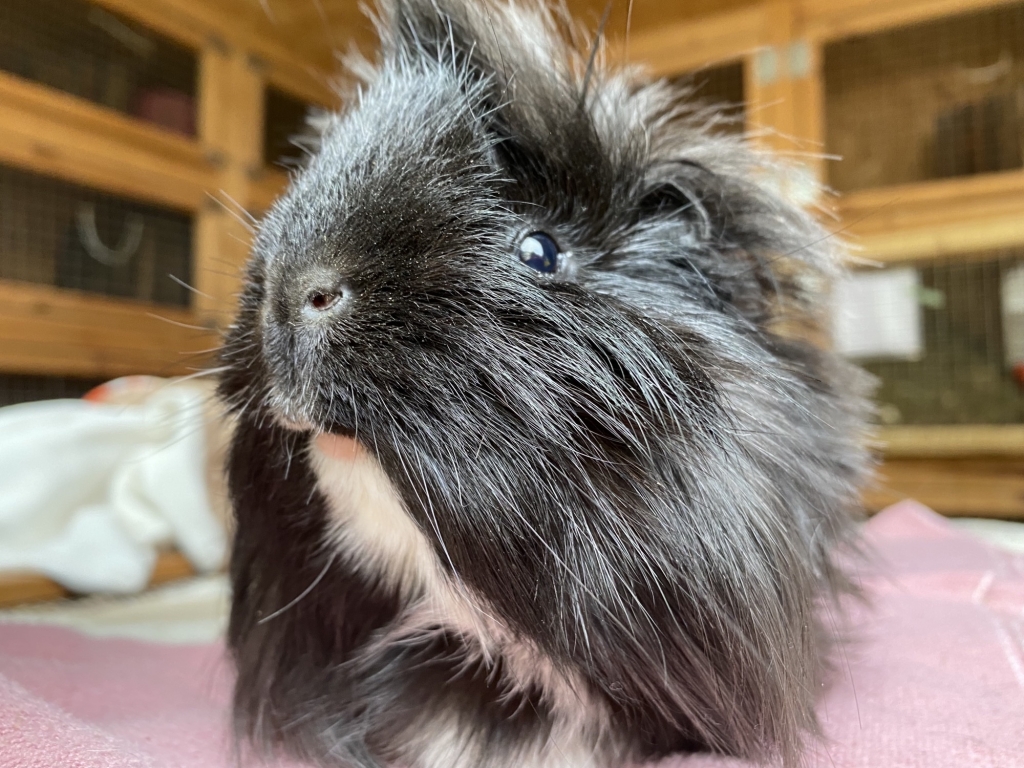
Bullied Guinea Pig No Longer A Sight For Sore Eyes
Rescued guinea pig Jacob is no longer a sight for sore eyes thanks to treatment for entropion at Davies Veterinary Specialists (Davies) in Hertfordshire – a condition which occurs rarely in this species.
Little Jacob was bought at a pet shop together with two others, but he was badly bullied by his two cage mates, resulting in numerous bite wounds. He also had a noticeable problem with one of his eyes.
His owner couldn’t cope with the situation and gave Jacob away, but luck was on the guinea pig’s side when he was rescued by Kate Wright, a diagnostic technician at Davies who runs a Guinea Pig Rescue Centre. Subsequently, the Linnaeus-owned small animal referral practice agreed to treat Jacob as a staff pet, at a reduced cost.
Rotating Intern Ula Rzeszutek found numerous infected bite wounds all over Jacob’s body, one of which had formed an encapsulated abscess. Davies ophthalmologist Adam Margetts dignosed entropion in Jacob’s right eye.
“Jacob must have been suffering in silence for a long time before he came to Katy’s rescue centre. When he arrived there, she realised that extensive injuries were hidden under his thick, long fur. She immediately rushed him to our hospital,” said Ula. “His wounds were malodorous and very painful. On the top of that, his right lower eyelid was rolling inwards, making his eye very sore. This kind of eyelid problem, called entropion, is not commonly seen in guinea pigs. Jacob was literally a sight for sore eyes, but we were confident that surgery would help him.”
Ula treated most of the bite wounds medically, but the persistent abscess had to be excised surgically.
“Guinea pig abscesses are problematic as they form a thick capsule which prevents antibiotic penetration - often the only option is to remove them surgically,” she explained.
Ula also performed a Hotz-Celsus procedure to correct lower eyelid entropion. Rodent anaesthesia is notoriously tricky, so experienced rodent veterinary nurse Amy Houghton helped with surgical planning and monitored Jacob throughout the procedure.
While Jacob was in surgery he was also castrated.
“Jacob has made a full recovery from all his treatment and is doing really well,” said Kate Wright. “He’s quite a timid chap - given everything he’s been through this is not a surprise, but I have managed to successfully pair him with a more confident guinea pig and they are very happy together.
“Although I do try to find permanent loving homes for the guinea pigs in my care, Jacob has really stolen my heart and I can safely say he has already found his forever home with me! I am very grateful to Ula and my colleagues for his expert treatment and care."
Davies veterinary nurse Amy Houghton worked for five years in an exotic referral first opinion veterinary practice, gaining significant experience with helping to anaesthetise small mammals, birds, reptiles and even monkeys from the local safari park zoo. She has the following tips for rodent anaesthesia:
· Whilst not licensed for use in small mammals, Sevoflurane has more desirable qualities over Isoflurane which may lead you to choosing it under the veterinary prescribing cascade. Small mammals tend to find the smell less aversive which is useful when mask anaesthetising. It also has a much more rapid onset and offset of action, meaning a quicker anaesthetic and recovery.
· A tight-fitting face mask is an efficient way to deliver a combination of oxygen, along with an anaesthetic inhalant, to ensure the patient is well anaesthetised before starting the surgery.
· Monitoring is particularly difficult in small mammals due to the size and limitations of what can be attached:
o A pulse oximetry probe on a foot will provide information on heart rate and oxygen saturation in the blood.
o A doppler probe on another foot, will give an audible depiction of pulse rate and quality.
o A capnograph inside the tight-fitting face mask, allows visualisation of respiratory rate and pattern.
· Small mammals have a large surface area to volume ratio, which means they lose heat a lot more easily. A low body temperature can cause a prolonged recovery, so it is important to keep the patient warm during the procedure. This can be achieved by sitting the patient on top of an active warming device called a bair hugger.
More from Davies Veterinary Specialists

 4 years ago
4 years ago  999 views
999 views

 3 days ago
3 days ago